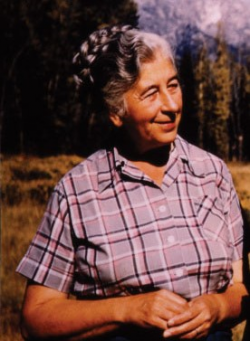Margaret Murie

- Born
- 18 August 1902
- Died
- 19 October 2003 (age 101)
Margaret ‘Mardy’ Murie was a naturalist and writer, and one of the first women to take a leading role in America’s conservation movement. She played a key role in establishing the Arctic National Wildlife Refuge in Alaska, for which she became known as ‘the grandmother of the conservation movement’.
In 1924, Murie was the first woman to graduate from the Alaska Agricultural College and School of Mines. She married Olaus Murie, who was working for the US Bureau of Biological Survey. Their honeymoon was an eight-month long expedition to study caribou in Alaska’s Brook Range. In 1927 they moved to Wyoming where Olaus was employed to study elk in the Teton mountains. Margaret kept detailed records of the specimens he collected.
Grandmother of the conservation movement
When Olaus was appointed part director of the Wilderness Society, Margaret became increasingly involved in conservation efforts. In 1956 they journeyed along the Sheenjek River in the Brooks Range, joined by zoologist George Schaller. Their studies, and persistence in promoting legislation, along with other campaigners such as Celia Hunter, led to the establishment of the Arctic National Wildlife Range in 1960. This was later to be expanded and become the Arctic National Wildlife Refuge.
The Muries campaigned for the Wilderness Act which became law in 1964, shortly after Olaus’s death. Margaret continued to work in conservation and in 1975 was appointed to identify lands in Alaska that were in need of protection. The Alaska National Interest Lands Conservation Act became law in 1980 and ensured protection for more than 100 million acres. She was awarded the Presidential Medal of Freedom by Bill Clinton in 1998 for her lifelong commitment to conservation.



